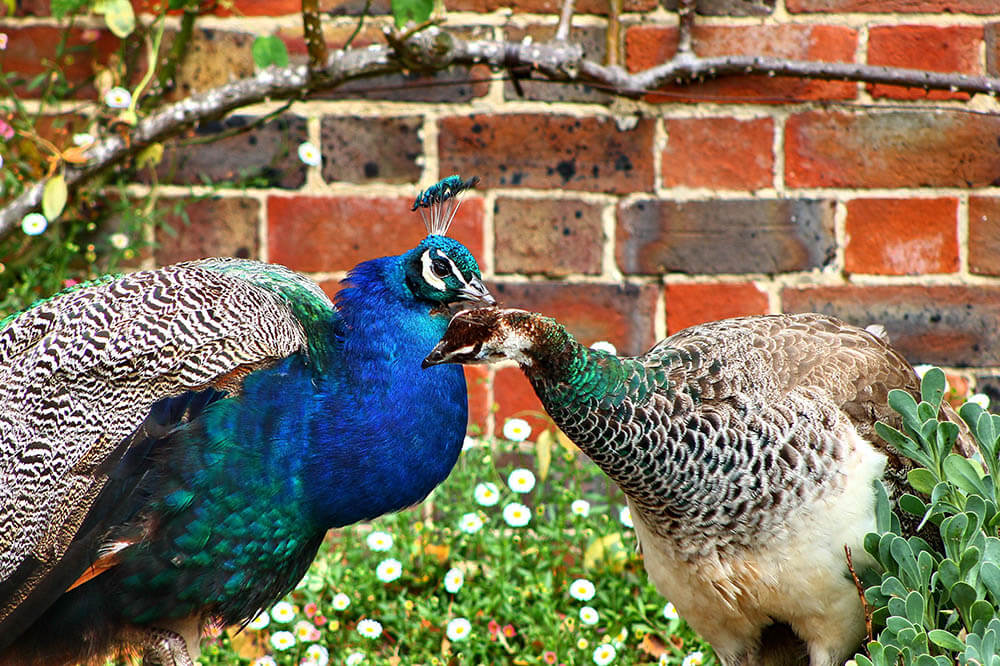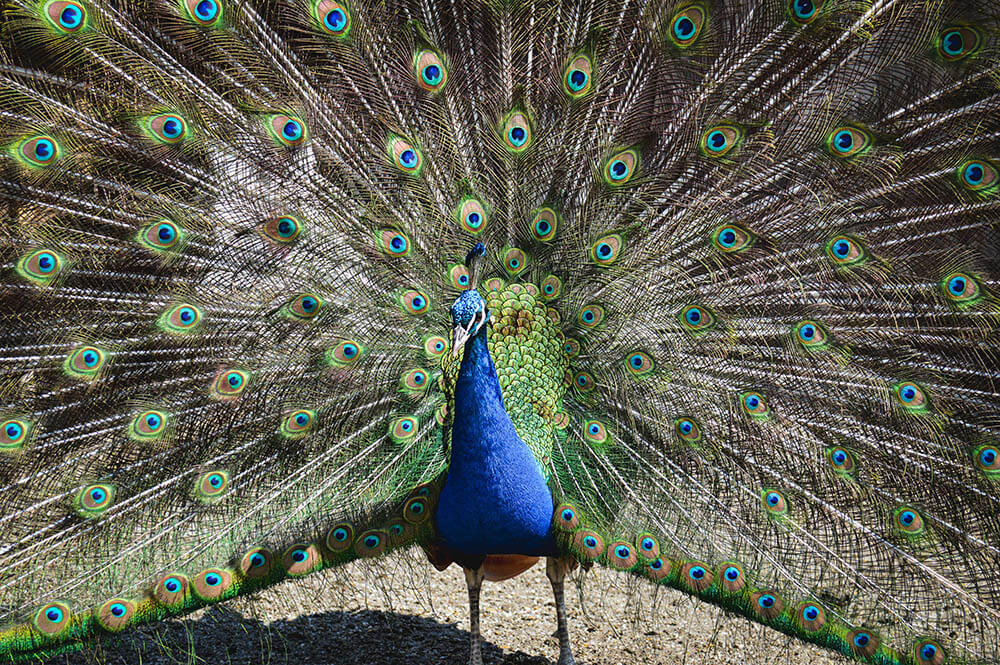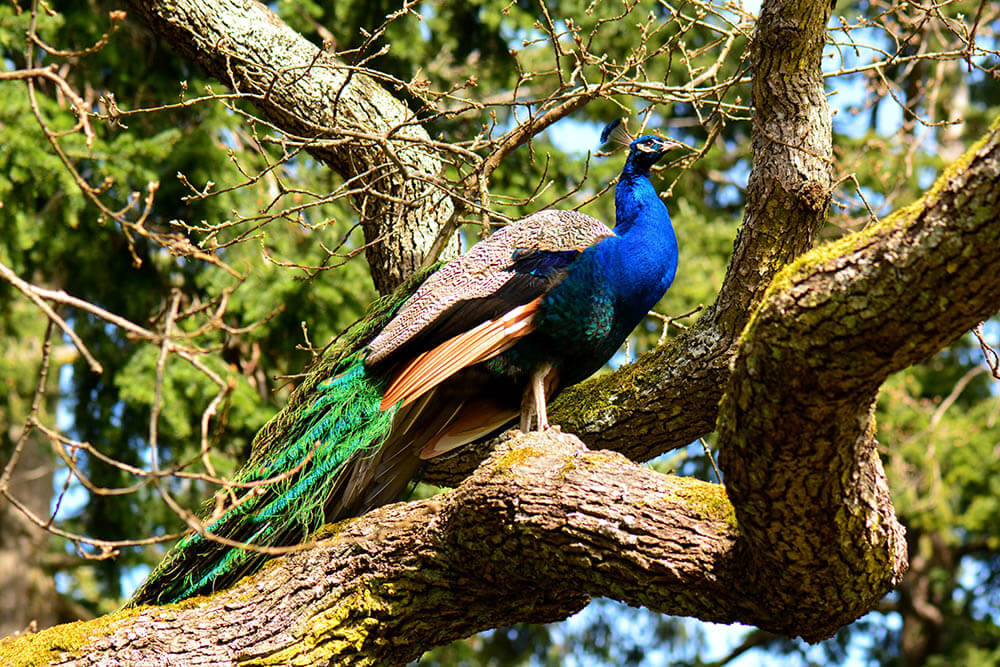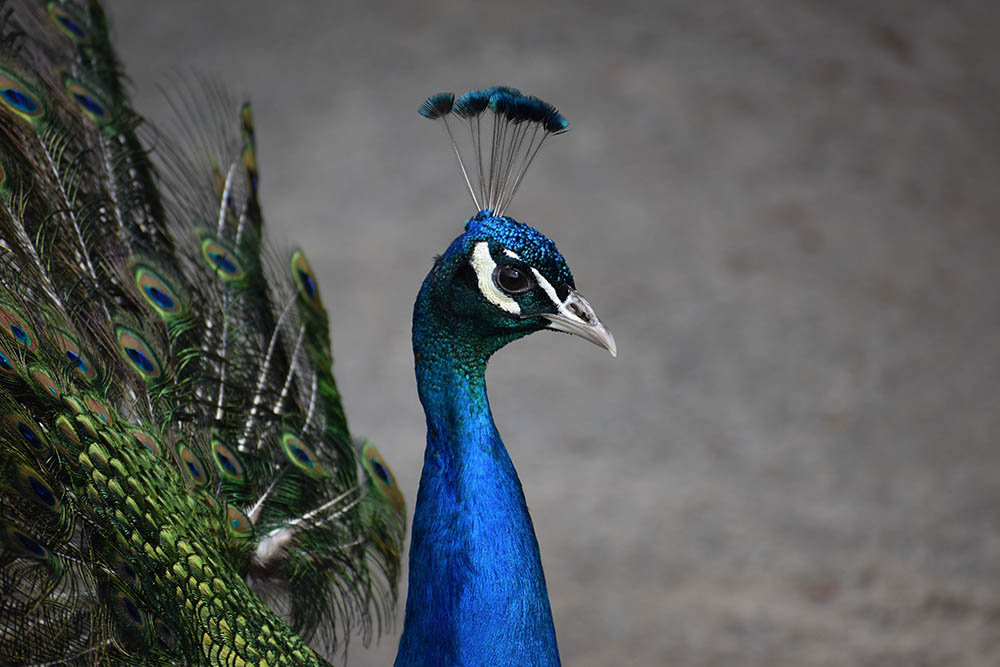Peafowl are among the most magnificent creatures on the planet. However, there’s nothing too extraordinary about many of their behaviors.
For example, they mate just like other birds do – using avian reproductive organs called cloacae. What make peafowl stand out, however, are their mating rituals, which are as fascinating as they are bizarre.
If you’re interested to learn how peafowl mate, keep reading!
Note: while these birds are popularly known as “peacocks,” the proper, gender-neutral term for the species is “peafowl.” Peacocks are male peafowl, while peahens are female peafowl.

First of All, What Is a Peafowl?
Peafowl are not one but three bird species. The most common species include the bright blue Indian peafowl (or Pavo cristatus), which is found in the Indian subcontinent, and the green Southeast Asian peafowl (or Pavo muticus). A rarer third species, the Congo peafowl (Afropavo congensis), makes its home in Central Africa’s Congo Basin.
Peafowl are beloved for their gorgeous plumage, specifically the peacock’s marvelous tail feathers, which he spreads out like a fan to attract females during mating season. Which brings us to…
“Peacocking” and Mate Selection
“Peacocking” is a term referring to how men use flashy behavior and clothing to give themselves an edge over male competitors when it comes to attracting women. This term was inspired by how actual peacocks behave when they’re interested in finding a peahen to mate with.
When the mating season begins around mid-spring, peacocks establish leks, which are small territories located near one another. These peacocks then perform courtship rituals to impress females in the hopes of getting them to mate with them.
Rituals include strutting to and fro while swaying their colorful plumage, which produces a rattling sound that gets the attention of peahens. Peacocks also do the one thing they’re most famous for – spread their long, extravagant tail feathers (a.k.a. a “train”) wide to create a large, fan-like shape. The bright colors and designs this act puts on display are alluring to peahens.
Peahens explore the various leks to thoroughly examine each peacock’s display. If a specific male adequately impresses a female, she selects him as her mate.

Mating and Fertilization
Once a peahen chooses the peacock she wants to mate with, she allows him to perch on her back.
Like all birds, both male and female peafowl have reproductive organs called cloacae. When the peacock and peahen align their cloacae, the peacock is able to transfer his sperm into the peahen’s body. This sperm then journeys up the peahen’s uterus to fertilize her egg.
Laying Eggs and Incubation
After fertilization, a peahen spends the next 10 to 12 days laying eggs.
After producing a clutch of eggs, a peahen ordinarily stops producing additional eggs so that she can devote her efforts to incubating said clutch. The incubation period takes around 28 to 30 days.
Peahens incubate their eggs like most birds do: by sitting on their eggs. The mother’s body heat warms the eggs, allowing the unhatched peafowl chick to develop, grow, and take form during the aforementioned 28 to 30 days.
While peahens normally produce around a dozen eggs, there’s a technique peafowl keepers use to ensure a peahen lays more eggs than usual. If a keeper removes a peahen’s eggs from her nest, she may lay one or two more clutches for a possible total of about 30 eggs. She’ll only be able to incubate ten or fewer eggs, but the rest can be incubated using 1) artificial incubation via the use of an incubation apparatus or 2) a foster mother such as a turkey hen.
Peafowl keepers can let their peahens incubate their eggs either in the open or in a large confined space such as a coop. Because younger peahens have trouble settling when confined, however, a peafowl keeper may instead have a foster mother sit on the egg or use artificial incubation.

Hatching and Brooding
Once the incubation period is complete, the peafowl chicks hatch from their eggs.
Mothers take exceptional care of their offspring. They use body language, vocalizations, and various examples to teach their chicks valuable life lessons, such as what foods are edible and what dangers to avoid. They’re also extremely protective of their offspring, usually resorting to violence if necessary; they won’t hesitate to use their beaks and talons to scare away predators.
It’s common for peafowl keepers to confine chicks with their mother for around a week, before allowing the chicks more freedom to leave and return to their mothers whenever they want.
Some keepers also recommend limiting the mother’s movements. After all, peahens enjoy roaming vast tracts of land with their offspring in tow. This increases the risk of the chicks getting harmed or lost during bad weather. When the chicks are six months old, however, their mother abandons them to let them fend for themselves.
Mating-Related Peafowl Aggression
Peafowl are known for being ill-tempered birds. However, mating season makes them particularly irritable. Peacocks experience a surge in hormones during this time – not to mention the pressure and frustration brought about by competing against other males make them more likely to behave aggressively towards one another.
Once a peacock has found a mate, he can grow extremely possessive and become convinced that any other peacock entering his space is trying to steal his mate. This can lead to violence as the first peacock defends his claim to said mate. And because peafowl aren’t the sharpest tools in the shed, a peacock could even mistake another species’ intentions; any creatures, including humans, approaching his area could become the subject of his anger.
Peahens are just as likely to act aggressively during mating season. As will be discussed further below, peahens tend to fight with other females to keep their chosen males to themselves. They’re also preparing nests in the hopes of producing eggs, so any creatures that come close to them and disturb them could be in danger of getting viciously attacked.
Both peahens and peacocks are highly protective of their eggs, so they’ll likely attack anything that comes within the vicinity of their nests.

Fabulous Peafowl Facts
Curious about peafowl? Read on to learn more about these captivating birds!
Peacocks are (generally) polygamous
Peacocks typically don’t settle for one mate, with a dominant male preferring to mate with more than one peahen per mating season. In captivity, however, some green peafowls form monogamous pairings.
Peahens also compete for mates
Interestingly enough, males aren’t the only ones who compete for females; peahens also compete with one another for the chance to be with a dominant male, sometimes getting violent in the process. Peahens may even repeatedly mate with a dominant peacock to prevent other females from mating with him.
Female preference ensures the species stays beautiful
Peahens usually prefer peacocks with the most impressive plumage, which guarantees that males with the flashiest tail feathers reproduce the most often. This, in turn, ensures the genes for the most beautiful feathers pass from one generation to the next, which is why this species has remained gorgeous for centuries.
In the wild, these birds breed in regions of thick vegetation, where extravagant displays of colorful tail feathers are more likely to grab the attention of potential mates.
Peahens can produce five to nine eggs per year
In general, peahens don’t produce eggs during their first year. Once they reach their second year of life, they start laying a few eggs. It’s only when they’re four, however, that they become capable of laying between five and nine eggs annually.
Peafowl eggs aren’t extraordinary
Peafowl may impress with their iridescent plumage, but their eggs are nothing to write home about.
The color of Indian peafowl eggs is “buff white,” which is a type of white with an extremely light blue tint. Southeast Asian peafowl eggs are much closer to pure white. Congo peafowl, on the other hand, lay buff-white eggs sporting small brown freckles.
Because peafowl are large birds, their eggs are bigger than chicken eggs.
Peafowl are sexually dimorphic
Peacocks don’t look the same as peahens. Those peafowls boasting vibrant blues and other colors as well as eye-catching decorative tail feathers? Those are peacocks. Peahens, while also alluring, have subtler colors such as brown and gray.
Only peacocks fan out their gorgeous tail feathers – a behavior known as “train rattling” that they engage in whenever they want to impress the ladies.
Peahen crests are sensors
Because of the peafowl’s stunning plumage, we often overlook the equally exquisite decoration sitting on top of its head: the crest.
While both peacocks and peahens have crests, peahen crests are not only beautiful but also important, as they act as sensors during mating. When a peacock rattles his tail feathers to attract peahens, a peahen sees this display as well as feels its movements thanks to her crest.

Conclusion
Peafowl mate by aligning their cloacae, which are reproductive organs common to all bird species.
It’s the peafowl mating ritual that separates peafowl from other birds. Peacocks fan out their spectacular tail feathers then engage in a lot of strutting to win over peahens. Peahens, in turn, compete with other females for the chance to reproduce with a dominant peacock. Once a peahen selects the dominant peacock to mate with, their cloacae align to allow fertilization to occur.
It’s the peahens’ selection of males with the most alluring plumage that ensures this species remains one of the most vibrantly colored birds on the planet.
